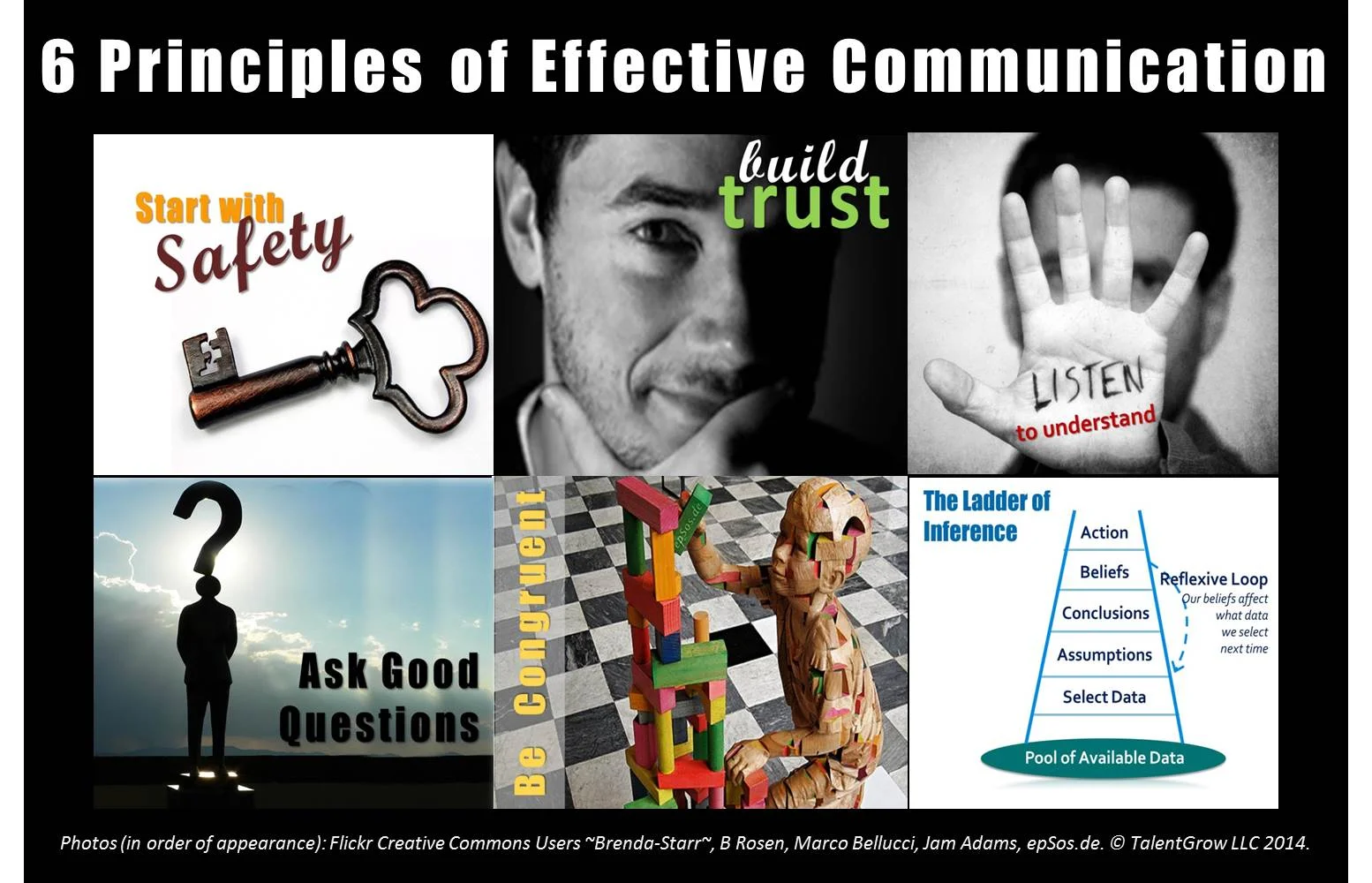Six Principles of Effective Communication
/Prefer to learn by listening? Good news! This content is now also available in audio form on episode 102 of the TalentGrow Show podcast! Listen here.
We all have relationships in which we communicate with ease, and others in which we feel like we’re “walking on eggshells” – always careful with our words, trying not to offend or create a defensive response. It’s natural to have different levels of communication chemistry with different personalities and there’s no way to fully level the playing field. Yet, it’s also possible to reduce the likelihood of defensiveness and to increase our success when we communicate with just about anyone, anywhere.
Here are six principles that can help you communicate more effectively:
1. Start with safety and reduce threat. As I discussed in a recent vlog about feedback and wrote about in this blog post, safety must be the underpinning assumption behind communication interactions, especially ones that are not easy to deliver or receive. Did you know that our brain responds to social/emotional threat in the same way that it responds to physical threat? We go into ‘fight or flight’ mode which pretty much bypasses rational thinking. We get fidgety, our field of view narrows, our working memory gets reduced, we have fewer insights, and become more pessimistic when the sense of threat kicks in (NeuroLeadership Institute). Doesn’t sound like a good way to have productive conversations, right?
2. Build trust. It looks and sounds simpler than it is, of course, but the more trust there is between the conversation partners, the higher the likelihood that the conversation will be productive and effective. Best-selling author Keith Ferrazzi describes three types of trust: Swift trust (giving people the benefit of the doubt initially), interpersonal trust (built over time through social interactions), and task-based trust (built by creating repeated patterns that show us as reliable, consistent, and responsive). Learn more about these and other ideas for building trust in my recent post about trust.
3. Listen to understand. As opposed to pretending to listen while waiting for your turn to talk or going over your grocery list in your mind as you look blankly at the person while they speak at you… You have to listen attentively. I loved how actor Alan Alda described good listening – he said that truly listening means being willing to be changed! (He talks about this starting at minute 5:44 on the linked video.)
4. Ask good questions. What are good questions? No question type (open-ended, closed-ended, probing, or leading) is inherently good or bad – all questions are good at certain times and not so good under other circumstances. Match the question to the need, and I suggest that most of us could err on the side of asking more open-ended questions (i.e., questions that require an answer that is fuller than yes, no, or one word or phrase; questions that require the person to expand and elaborate on what they know, think, or feel). But sometimes you just need specific information, so ask a closed-ended question. And always ask from a place of genuine curiosity.
5. Create congruence between the verbal and non-verbal parts of your message. Have you ever seen someone cross their arms across their chest, stomp their foot on the floor, frown their brow and shout, “I’M NOT ANGRY!!!”? Were you sold? Not in the least! We can tell when there’s a mismatch between what the words are saying and HOW they are spoken, and our brain is in search of the truth. And thanks to Dr. Albert Mehrabian's research into non-verbal communication, which has been replicated by scores of social scientists and psychologists for over 40 years, we know that when faced with a mismatch between the verbal and non-verbal part of the message, we tend to believe the non-verbal as the real message, by a long shot. So, to have effective communication you must say what you mean and mean what you say, and don’t try to mask intense feelings because they will leak out, one way or another.
6. Stay low on the ladder of inference. In every interaction, the parties in communication selectively notice information, make assumptions, draw conclusions and make decisions about it. We then formulate beliefs about the person, topic or situation and take actions accordingly. While this process is natural, we should defend against our tendency to ‘climb up the ladder’ and minimize actions that are not grounded in facts. Check out this blog post about the ladder of inference and do the fun video exercise. But be sure to work on staying low (or climbing back down) the ladder if you want to have reality-based, honest, and fair conversations.
Which of these six principles of effective communication do you want to pay closer attention to? Tell me your development intention in the comments below and let’s get a conversation going about how to ratchet up our communication success! See you in the comments!
Sign up to my free weekly newsletter and get more actionable tips and ideas for making yourself a better leader and a more effective communicator! It’s very short and relevant with quick tips, links, and news about leadership, communication, and self-development. Sign up now!
Also, subscribe to my podcast, The TalentGrow Show, on iTunes to always be the first in the know about new episodes of The TalentGrow Show! http://apple.co/1NiWyZo
You Might Also Like these Posts:
102: [Solo] Six Principles of Effective Communication on The TalentGrow Show with Halelly Azulay
Ep25: How to be a more engaging communicator


